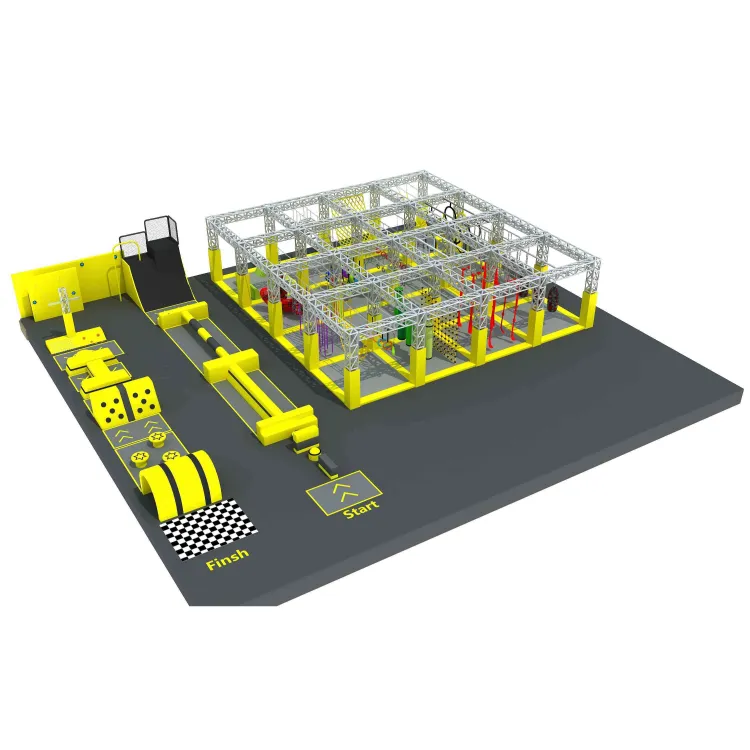Essential Safety Features in Kids' Climbing Wall Designs
Proper Fall Zone Engineering
A good fall zone matters a lot when designing climbing walls for kids since it stops them getting hurt when they tumble down. When there's a clearly marked area where kids can land, it keeps them safer overall and cuts down on accident risks during climbs. Foam mats or rubber floors work best for absorbing impact after a fall. Designers need to think about how high the wall is, where most weight will land, and how many kids might be using it at once before setting up the fall zone properly. Getting this right means kids stay protected but still get to enjoy the thrill of climbing without unnecessary dangers holding them back.
Age-Appropriate Hold Selection
When picking out climbing holds for kids, matching them to the child's age and ability makes all the difference in keeping things safe while still fun. Younger climbers need holds that fit their tiny hands properly so they can actually grab onto something securely and feel confident as they climb. The right size holds help prevent accidents and keep kids wanting to come back for more because climbing becomes something they can do rather than struggle with. Checking how durable these holds are before buying is important too since kids tend to be pretty rough on equipment. A good hold should last through plenty of climbs without cracking or breaking apart. Getting holds that work well for different ages helps strike that sweet spot between challenge and safety, which teaches kids to push themselves just enough without getting discouraged or hurt along the way.
Popular Climbing Wall Types for Children
Low-Height Bouldering Walls
Bouldering walls at low heights were made with kids in mind so they can climb around without needing any harnesses, which makes getting started much easier and safer too. These walls aren't very tall, just right for little climbers wanting to try out climbing while taking few risks. Since there's no need for ropes or harnesses, children get to figure things out on their own as they work through different climbing challenges, something that builds their confidence over time. Schools and playgrounds often install these kinds of walls because they come with all sorts of interesting angles and handholds that keep kids engaged during playtime. The whole setup lets children concentrate on how their body moves and what techniques work best, gradually building up strength and sharper thinking skills without depending on extra safety stuff. Most parents love seeing these walls around since it's pretty straightforward to watch from a distance and there's not much equipment lying around to worry about, which explains why so many families and schools choose them when setting up outdoor spaces.
Auto-Belay Top Rope Systems
Auto belay top rope systems give kids a great way to climb all by themselves, no partner needed for those solo adventures up the wall. What makes these systems special is their automatic descent feature that cuts down fall risks pretty dramatically while keeping things safe overall. They've got this weight sensitive tech built in too, so whatever the kid weighs, the system adjusts accordingly for better safety control when coming down. These auto belays work really well for younger climbers because they stay secure throughout but still let kids feel independent at the same time. Kids gain confidence faster with this setup since they don't have to worry about falling, just concentrate on learning proper climbing techniques. Plus, since auto belays adjust so well, they fit into different situations whether it's just fun climbing sessions or more serious competition training environments.
Creative Themed Climbing Wall Designs
Nature-Inspired Rock Formations
When rock walls get nature inspired, regular climbing structures become something special for kids to interact with. Think mountains rising up, hidden caves waiting to be explored, or even forest canopies overhead. These aren't just pretty decorations either. The real magic happens when designers actually replicate how rocks feel in real life. Kids get this amazing tactile experience that feels almost like touching actual stone formations. And let's talk about color schemes too. Bright greens for grassy areas, browns for tree trunks, maybe some blue accents for water features. This helps little climbers recognize different parts of ecosystems as they scale up. What we end up with are climbing walls that do double duty. They keep kids active physically while letting them pretend they're exploring wild places. Many parents report seeing their children describe entire imaginary worlds after climbing sessions on these themed walls.
Adventure Story Concepts
When adventure stories get incorporated into climbing walls, it takes the whole experience to new heights. Kids love getting lost in these tales while they climb, which makes the activity so much more than just physical exercise. Walls decorated with pirate ships or space adventures really grab attention from little climbers who want to be part of something bigger than themselves. The best part? These themed routes naturally bring kids together as they figure out how to tackle obstacles together. We've seen groups of children working side by side to solve climbing puzzles on walls featuring dragons or treasure maps. Colorful pictures and special markers help kids follow along their journey across the wall, turning each climb into an actual quest with hidden surprises waiting around every corner. Beyond entertainment value, this kind of setup actually helps develop important thinking skills when kids have to plan their moves around story elements. Parents report seeing real improvements in how kids communicate and solve problems during these climbing sessions. For many families, adventure themed walls create lasting memories while giving kids both fun and valuable life lessons wrapped up in one exciting package.

Space-Efficient Climbing Wall Solutions
Modular Panel Systems
Climbing walls built with modular panel systems give users plenty of options when it comes to layout and design, which makes them great choice for smaller gyms or school facilities where space is tight. Gym managers and educators can move around panels or add new ones whenever they need to adjust things based on what's happening at their facility. Schools especially find this helpful when dealing with fluctuating class sizes throughout the year or when community groups start using the space more frequently. But before jumping into installation, safety should be front of mind. The weight limits matter a lot, and how easy panels are to put together affects both setup time and long term stability. Using quality materials from reputable manufacturers goes a long way toward creating something that lasts through years of regular climbing activity and different types of users.
Multi-Functional Structures
Climbing walls that serve multiple functions really get the most out of the space they occupy in any facility. When designers add things like slides or other play areas to the basic climbing structure, what starts as just another wall becomes something much more interesting for visitors. Take those walls that have built-in gymnastics bars or resistance bands for strength training - suddenly there's a whole range of different workouts possible right there on the same surface. Kids especially seem to love this kind of setup because it keeps them engaged longer than traditional climbing alone would. The creative design aspect matters a lot too. Facilities that think outside the box when planning these multi-use walls tend to see higher usage rates overall, which makes sense since people are naturally attracted to spaces where they can do several things at once without having to move around much.
These concurrent designs highlight the importance of innovation in crafting climbing-wall solutions that cater to space constraints and still offer comprehensive, dynamic features. Integrating these elements can indeed transform a simple climbing area into an interactive and engaging gym space.
Materials and Texture Options
Faux Rock Surfaces
Artificial rock walls offer a great way to create authentic climbing experiences without compromising on safety or lasting power in places where people actually want to have fun. These fake rocks copy how real stone feels and looks, giving climbers those same handholds and foot placements they'd find on mountainsides. Schools and parks love them because kids won't get hurt falling off these structures. Plus, manufacturers make sure these synthetic rocks stand up to rain, sun, and whatever else Mother Nature throws at them when installed outside. The rough textures help prevent slips and slides, but there's another bonus too many parents don't realize: little climbers start pretending they're conquering Everest every time they tackle one of these walls. Watching their imaginations run wild as they scale these artificial mountains is pretty cool stuff.
Colorful Polymer Holds
Colorful polymer climbing holds really stand out on walls and draw kids in for active play. The material is tough enough to last but light enough that putting them up or taking them down isn't a hassle at all. Because they can be moved around so easily, gyms can change routes frequently which keeps things interesting for climbers. There's literally hundreds of different designs available too. Kids start recognizing colors and shapes as they climb, which actually helps their brain development without anyone even realizing it's happening. These bright little pieces grab attention first, then keep it by making climbing both fun and mentally stimulating at the same time. Most parents probably don't realize how much their kids are learning while having all this fun on the wall.
Adjustable Route Configurations
Adding adjustable route setups to climbing walls makes all the difference when it comes to keeping things interesting as climbers progress through different skill levels. These adjustable systems let instructors change things up quickly without much hassle, so the wall doesn't get boring after a few sessions. Climbers can work on specific areas where they need improvement too. Some might focus on building stamina during long climbs while others practice working together on multi-person routes. What really stands out about these adjustable features is how they accommodate everyone from beginners just starting out to advanced climbers looking for a real challenge. That kind of flexibility turns ordinary climbing walls into something special for both schools teaching kids and gyms catering to adults who want to stay active.
Integrated Games and Challenges
Adding games and interactive challenges to climbing walls really gets kids talking and competing with each other in a friendly way. When we design these activities around what kids are learning in school, like mixing in some basic math problems or simple science concepts, it turns regular climbing sessions into actual learning experiences. The fun stuff on the walls makes the whole place more interesting for everyone involved. Kids end up building their stamina while figuring out how to get past obstacles, which helps them think through problems better too. Putting these game elements right into the climbing structures means little climbers aren't just getting exercise, they're also sharpening their minds without even realizing it. This kind of setup creates something special where kids grow physically strong and mentally sharp all at once, all while having a great time doing it.
FAQs
What materials are recommended for fall zones in kids' climbing walls?
Soft materials such as foam pads or rubber flooring are recommended to effectively cushion impacts and ensure safety in fall zones.
How do adventure-themed climbing walls benefit children?
Adventure-themed climbing walls offer dynamic experiences that foster imagination, social interaction, and problem-solving skills, making climbing both fun and educational.
Why are modular panel systems important in climbing wall designs?
Modular panel systems provide flexibility in rearranging and expanding wall designs, making them ideal for adapting to changing needs in limited spaces.

